
- Homepage
- Certification
- Composition
- Date
- Denomination
- Ae Prutah (34)
- Ae3 (14)
- Antoninianus (104)
- Ar Denarius (42)
- Aurelianianus (12)
- Aureus (145)
- Bi Double Denarius (24)
- Bi Nummus (22)
- Centenionalis (16)
- Cistophorus (24)
- Denarius (1277)
- Double Denarius (63)
- Dupondius (16)
- Nummus (119)
- Prutah (27)
- Quadrigatus (13)
- Sestertius (127)
- Siliqua (15)
- Solidus (169)
- Tetradrachm (21)
- Other (604)
- Ruler
- Antoninus Pius (53)
- Augustus (141)
- Caracalla (53)
- Constantine I (57)
- Constantine Ii (29)
- Domitian (58)
- Gallienus (37)
- Gordian Iii (62)
- Hadrian (100)
- Marcus Aurelius (69)
- Nero (113)
- Nerva (31)
- Philip I (66)
- Septimius Severus (36)
- Severus Alexander (69)
- Theodosius Ii (32)
- Tiberius (69)
- Trajan (97)
- Trajan Decius (28)
- Vespasian (78)
- Other (1610)
- Year
NGC Ch XF ROMAN COINS MAXIMINUS I, AD 235-238. AR Denarius. A747
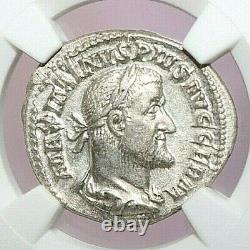
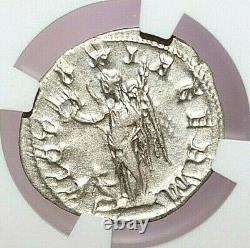
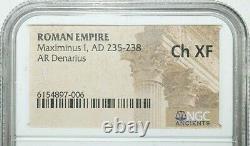
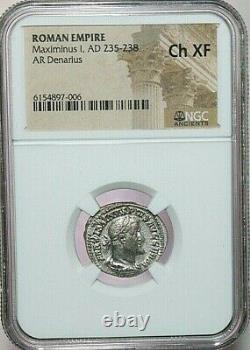
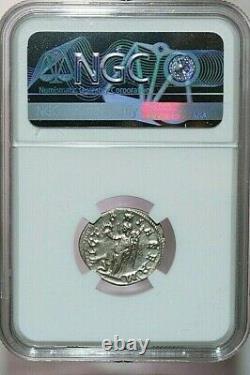


Dear Customers, you will receive exactly the same item which you see on the pictures, not similar or other. Please read the description carefully and review the photos. Bust of Maximinus Thrax in the Capitoline Museums. May 238 (aged 64) Aquileia.
Imperator Caesar Gaius Julius Verus Maximinus Augustus. Gaius Julius Verus Maximinus "Thrax" the Thracian. May 238 was Roman emperor. His father was an accountant in the governor's office and sprang from ancestors who were Carpi.
Tribe, a people whom Diocletian. Would eventually drive from their ancient abode in Dacia. Roman Antiquities, book XXVIII, Ammianus Marcellinus.
Maximinus was the commander of the Legio IV Italica. Was assassinated by his own troops in 235. The Pannonian army then elected Maximinus emperor.
In 238 which came to be known as the Year of the Six Emperors. , a senatorial revolt broke out, leading to the successive proclamation of Gordian I. As emperors in opposition to Maximinus. Maximinus advanced on Rome to put down the revolt, but was halted at Aquileia.
Where he was assassinated by disaffected elements of the Legio II Parthica. Maximinus is described by several ancient sources, though none are contemporary except Herodian. He was a so-called barracks emperor. His rule is often considered to mark the beginning of the Crisis of the Third Century. Maximinus was the first emperor who hailed neither from the senatorial class.Most likely Maximinus was of Thraco-Roman. Origin (believed so by Herodian in his writings). According to the notoriously unreliable Augustan History.
(Historia Augusta), he was born in Thrace. Mother, an Iranian people of the Scythian-Sarmatian branch; however, the supposed parentage is a highly unlikely anachronism.As the Goths are known to have moved to Thrace from a different place of origin much later in history and their residence in the Danubian. Area is not otherwise attested until after Maximinus had lived his full life and died. Writing that "the word'Gothia' should have sufficed for condemnation" of the passage in the Augustan History , felt that the burden of evidence from Herodian.
And elsewhere pointed to Maximinus having been born in Moesia. The references to his "Gothic" ancestry might refer to a Thracian.
Origin the two populations were often confused by later writers, most notably by Jordanes. , as suggested by the paragraphs describing how "he was singularly beloved by the Getae, moreover, as if he were one of themselves" and how he spoke "almost pure Thracian".
On the contrary, Bernard Bachrach suggests that the Historia Augusta use of a term not used in Maximinus time "Gothia" is hardly sufficient cause to dismiss its account. After all, the names it gives for Maximinius' parents are legitimate Alan and Gothic appellations.
Hence, Bachrach argues, the most straightforward explanation is that the author of the Historia Augusta relied on a legitimate third century source, but substituted its terminology for that concurrent in his own day. Accordingly, Maximinus' ancestry very much remains an open question.
His background was, in any case, that of a provincial of low birth, and he was seen by the Senate. As a barbarian, not even a true Roman, despite Caracalla. S edict granting citizenship to all freeborn inhabitants of the Empire. According to the Augustan History , he was a shepherd. Leader before joining the Imperial Roman army.
To comment that a man who would have been in other circumstances a Godfather. In many ways, Maximinus was similar to the later Thraco-Roman emperors of the 3rd5th century Licinius. , elevating themselves, via a military career, from the condition of a common soldier. In one of the Roman legions.
To the foremost positions of political power. He joined the army during the reign of Septimius Severus. But did not rise to a powerful position until promoted by Alexander Severus.Maximinus was in command of Legio IV Italica. Composed of recruits from Pannonia.
Who were angered by Alexander's payments to the Alemanni. And his avoidance of war. The troops, who included the Legio XXII Primigenia. Elected the stern Maximinus, killing young Alexander and his mother at Moguntiacum modern Mainz.
Acclaimed him emperor, and their choice was grudgingly confirmed by the Senate. Who were displeased to have a peasant as emperor. From February to December 236 AD; ref. Maximinus hated the nobility and was ruthless towards those he suspected of plotting against him.
He began by eliminating the close advisors of Alexander. His suspicions may have been justified; two plots against Maximinus were foiled. The first was during a campaign across the Rhine. When a group of officers, supported by influential senators, plotted to destroy a bridge across the river, in order to strand Maximinus in hostile territory. They planned to elect senator Magnus.Emperor afterwards, but the conspiracy was discovered and the conspirators executed. The second plot involved Mesopotamian. Archers who were loyal to Alexander.
They planned to elevate Quartinus. But their leader Macedo changed sides and murdered Quartinus instead, although this was not enough to save his own life.The accession of Maximinus is commonly seen as the beginning of the Crisis of the Third Century. (also known as the "Military Anarchy" or the "Imperial Crisis"), the commonly applied name for the crumbling and near collapse of the Roman Empire between 235 and 284 caused by three simultaneous crises: external invasion, internal civil war, and economic collapse. Maximinus' first campaign was against the Alemanni, whom he defeated despite heavy Roman casualties in a swamp in the Agri Decumates.
After the victory, Maximinus took the title Germanicus Maximus , raised his son Maximus to the rank of caesar. And deified his late wife Paulina.
Maximinus may have launched a second campaign deep into Germania, defeating a Germanic tribe beyond the Weser. In the Battle at the Harzhorn. Securing the German frontier, at least for a while, Maximinus then set up a winter encampment at Sirmium. And from that supply base fought the Dacians.
During the winter of 235236. In 2019 Israeli researchers translated a milestone found in the Moshav Ramot village in Golan Heights. They were able to identify the name of Maximinus on the milestone. The roads themselves were much older suggesting that a massive renovation project was undertaken during his rule on those roads. Gordian I and Gordian II. Part of a series on Roman imperial dynasties. Year of the Six Emperors. Early in 238, in the province of Africa. A treasury official's extortions through false judgments in corrupt courts against some local landowners ignited a full-scale revolt in the province. The landowners armed their clients and their agricultural workers and entered Thysdrus modern El Djem. , where they murdered the offending official and his bodyguards and proclaimed the aged governor of the province, Marcus Antonius Gordianus Sempronianus Gordian I. , and his son, Gordian II. The Senate in Rome switched allegiance, gave both Gordian and Gordian II the title of Augustus.And set about rousing the provinces in support of the pair. Immediately assembled his army and advanced on Rome, the Pannonian legions leading the way. Meanwhile, in Africa, the revolt had not gone as planned.
The province of Africa was bordered on the west by the province of Numidia. Nursed a long-standing grudge against the Gordians and controlled the only legionary unit III Augusta. He marched on Carthage and easily overwhelmed the local militias defending the city. Gordian II was killed in the fighting and, on hearing this, Gordian I hanged himself with his belt. Pupienus, Balbinus, and Gordian III. Ruins of Imperial Palace at Sirmium.When the African revolt collapsed, the Senate found itself in great jeopardy. Having shown clear support for the Gordians, they could expect no clemency from Maximinus when he reached Rome. In this predicament, they remained determined to defy Maximinus and elected two of their number, Pupienus and Balbinus.
When the Roman mob heard that the Senate had selected two men from the patrician. Class, men whom the ordinary people held in no great regard, they protested, showering the imperial cortège with sticks and stones. A faction in Rome preferred Gordian's grandson Gordian III. , and there was severe street fighting.
The co-emperors had no option but to compromise, and, sending for the grandson of the elder Gordian they appointed him Caesar. Maximinus marched on Rome, but Aquileia. Closed its gates against him. His troops became disaffected during the unexpected siege of the city. At which time they suffered from starvation.
In May 238, soldiers of the II Parthica. In his camp assassinated him, his son, and his chief ministers.Their heads were cut off, placed on poles, and carried to Rome by cavalrymen. Pupienus and Balbinus then became undisputed co-emperors. However, they mistrusted each other, and ultimately both were murdered by the Praetorian Guard, making Gordian III. Unable to reach Rome, Thrax never visited the capital city during his reign. According to early church historian Eusebius of Caesarea.
The Imperial household of Maximinus' predecessor, Alexander, had contained many Christians. Eusebius states that, hating his predecessor's household, Maximinus ordered that the leaders of the churches should be put to death.
According to Eusebius, this persecution of 235 sent Hippolytus of Rome. Into exile, but other evidence suggests that the persecutions of 235 were local to the provinces where they occurred rather than happening under the direction of the Emperor. It is more likely that the Schism caused such strife between both factions that peace and order in the urbs were disrupted, causing Maximinus to intervene by exiling the two quarrelers. Which modern scholars however treat with extreme caution. Ancient sources, ranging from the unreliable Historia Augusta.
Speak of Maximinus as a man of significantly greater size than his contemporaries. He is, moreover, depicted in ancient imagery as a man with a prominent brow, nose, and jaw symptoms of acromegaly. Was said to be so large that he wore his wife's bracelet. As a ring for it. According to Historia Augusta , he was of such size, so Cordus reports, that men said he was eight-foot, one finger c. 2.4 metres in height. It is very likely however that this is one of the many exaggerations in the Historia Augusta , and is immediately suspect due to its citation of "Cordus", one of several fictitious authorities the work cites. Although not going into the supposedly detailed portions of Historia Augusta , the historian Herodian, a contemporary of Maximinus, mentions him as a man of greater size, noting that: He was in any case a man of such frightening appearance and colossal size that there is no obvious comparison to be drawn with any of the best-trained Greek athletes or warrior elite of the barbarians.Some historians interpret the stories on Maximinus' unusual height (as well as other information on his appearance, like excessive sweating and superhuman strength) as popular stereotyped attributes which do no more than intentionally turn him into a stylized embodiment of the barbarian bandit or emphasize the admiration and aversion that the image of the soldier evoked in the civilian population. Maximinus Thrax Roman Emperor 235238.
The item "NGC Ch XF ROMAN COINS MAXIMINUS I, AD 235-238. A747" is in sale since Wednesday, April 21, 2021. This item is in the category "Coins & Paper Money\Coins\ Ancient\Roman\ Imperial (27 BC-476 AD)".bean_medals" and is located in Riga, centrs. This item can be shipped worldwide.
- Cleaned/Uncleaned: Cleaned
- Modified Item: No
- Composition: Silver
- Certification Number: 6154897-006
- Ruler: Maximinus Thrax
- Historical Period: Roman: Imperial (27 BC-476 AD)
- Certification: NGC
- Provenance: Ownership History Not Available
- Denomination: Denarius
- KM Number: 6154897-006
- Date: 235-238 AD
- Era: Ancient
- Grade: Ch XF
- Year: 235-238 AD

